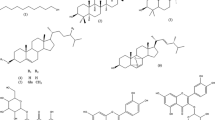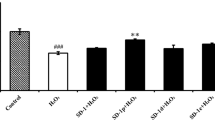Abstract
A repeated column chromatography for Forsythia koreana Nakai. flowers afforded a phenylethane glycoside, which was identified as 8′-(3,4-dihydroxyphenyl)ethyl-O-α-l-rhamnopyranosyl-(1 → 4)-2-O-(E)-caffeoyl-α-l-arabinopyranoside based on spectroscopic analyses of 1D NMR (1H-NMR, 13C-NMR, DEPT), 2D NMR (gCOSY, gHSQC, gHMBC), FAB/MS, specific rotation, and IR spectrometry. This compound was isolated from F. koreana flower for the first time in this study. The compound showed scavenge activities in ORAC and DPPH radicals with the values of 0.83 ± 0.01 and 84.66 ± 0.75% (at the concentration of 500 ppm), respectively. It also inhibited production of NO for RAW 264.7 stimulated by LPS and protected oxidative stress induced by glutamate in HT22-immortalized hippocampal. The IC50 on inhibition of NO production and EC50 value on protective efficacy of oxidative stress were 78.72 ± 1.43 μM and 176.25 ± 7.23 μM, respectively. These results demonstrate that the phenylethanoid glycoside might be useful as a neuroprotective agent because of their antioxidant, anti-inflammatory, and neuroprotective effects.

Similar content being viewed by others
References
Ames BN (1983) Dietary carcinogens and anticarcinogens: oxygen radicals and degenerative diseases. Science 221:1256–1264
Bursa SY, Oleszek W (2001) Antioxidant and antiradical activities of flavonoids. J Agric Food Chem 49:2774–2779
Choi YH, Kim J, Yoo KP (2003) High performance liquid chromatography-electrospray lonization MS–MS analysis of Forsythia koreana fruits, leaves, and stems. Enhancement of the efficiency of extraction of arctigenin by use of supercritical-fluid extraction. Chromatographia 57:73–79
De Marino S, Festa C, Zollo F, Incollingo F, Raimo G, Evangelista G, Iorizzi M (2012) Antioxidant activity of phenolic and phenylethanoid glycosides from Teucrium polium L. Food Chem 133:21–28
Ebrahimzadeh MA, Nabavi SF, Nabavi SM (2009) Antioxidant activities of methanol extract of Sambucus ebulus L. flower. Pak J Biol Sci 12:447
El-Desouky SK, Kim YK (2008) A phenylethanoid glycoside and other constituents from the fruits of Forsythia koreana. Z Naturforsch B 63:90–94
Forbes AM, Meier GP, Haendiges S, Taylor LP (2014) Structure-activity relationship studies of flavonol analogues on pollen germination. J Agric Food Chem 62:2175–2181
Georgiev M, Alipieva K, Orhan I, Abrashev R, Denev P, Angelova M (2011) Antioxidant and cholinesterases inhibitory activities of Verbascum xanthophoeniceum Griseb. and its phenylethanoid glycosides. Food Chem 128:100–105
Gey KF (1990) The antioxidant hypothesis of cardiovascular disease: epidemiology and mechanisms. Biochem Soc Trans 18:1041–1045
Hawas UW, Gamal-Eldeen AM, El-Desouky SK, Kim YK, Huefner A, Saf R (2013) Induction of caspase-8 and death receptors by a new dammarane skeleton from the dried fruits of Forsythia koreana. Z Naturforsch C 68:29–38
Jalgaonwala RE, Bhavna VM, Raghunath TM (2017) A review: natural products from plant associated endophytic fungi. J Microbiol Biotechnol Res 1:21–32
Kikuta Y, Ueda H, Nakayama K, Katsuda Y, Ozawa R, Takabayashi J, Hatanaka A, Matsuda K (2011) Specific regulation of pyrethrin biosynthesis in Chrysanthemum cinerariaefolium by a blend of volatiles emitted from artificially damaged conspecific plants. Plant Cell Physiol 52:588–596
Kim IR (2009) Herbal medicine. Jungumsa, Seoul, pp 242–243
Kriengsak T, Unaroj B, Kevin C, Luis CZ, David HB (2006) Comparison of ABTS, DPPH, FRAP, and ORAC assays for estimating antioxidant activity from guava fruit extracts. J Food Comp Anal 19:669–675
Lee JH, Lee JY, Kim TD, Kim CJ (2010) Antiasthmatic action of dibenzylbutyrolactone lignans from fruits of Forsythia viridissima on asthmatic responses to ovalbumin challenge in conscious guinea-pigs. Phytother Res 25:387–395
Lim H, Lee JG, Lee SH, Kim YS, Kim HP (2008) Anti-inflammatory activity of phylligenin, a lignan from the fruits of Forsythia koreana, and its cellular mechanism of action. J Ethnopharmacol 118:113–117
Liu YL, He WJ, Mo L, Shi MF, Zhu YY, Pan S, Li XR, Xu QM, Yang SL (2013) Antimicrobial, anti-inflammatory activities and toxicology of phenylethanoid glycosides from Monochasma savatieri Franch. ex Maxim. J Ethnopharmacol 149:431–437
Liu YG, Li X, Xiong DC, Yu B, Pu X, Ye XS (2015) Synthetic phenylethanoid glycoside derivatives as potent neuroprotective agents. Eur J Med Chem 95:313–323
Mikanagi Y, Yokoi M, Ueda Y, Saito N (1995) Flower flavonol and anthocyanin distribution in subgenus Rosa. Biochem Syst Ecol 23:183–200
Mosmann T (1983) Rapid colorimetric assay for cellular growth and survival: application to proliferation and cytotoxicity assays. J Immunol Methods 65:55–63
Nakai T (1926) Notulae ad Plantas Japoniae et Koreae XXXII. Bot Mag (Tokyo) 40:463–495
Newman DJ, Cragg GM (2007) Natural products as sources of new drugs over the last 25 years. J Nat Prod 70:461–477
Oh HJ, Park IJ, Kim EA, Kim TH, Yang YY, Kim AY, Choi SH, Oh EJ, Lee YG, Kim HG, Baek NI (2015) Evaluation of spring flowers extracts for functionality as cosmetics. Res Collect Inst Life Sci Resour 34:4–11
Orhan IE (2012) Biotechnological production of plant secondary metabolites. Bentham ebook, Sharjah, p 107
Ou B, Hampsch WM, Prior RL (2001) Development and validation of an improved oxygen radical absorbance capacity assay using fluorescein as the fluorescent probe. J Agric Food Chem 49:4619–4626
Park YJ, Kim HJ, Heo BG (2007) Anti-microbial, antioxidant and anti-inflammation effects with of the flower and the young leaf extracts in oriental cherry plants. People Plants Environ 10:43–49
Park JH, Jung YJ, Sabina S, Lee SM, Lee TH, Lee CH, Han DS, Kim JY, Baek NI (2014) Inhibition of NO production in LPS-stimulated RAW 264.7 macrophage cells with curcuminoids and xanthorrhizol from the rhizome of Curcuma xanthorrhiza Roxb. and quantitative analysis using HPLC. Appl Biol Chem 57:407–412
Xue Z, Yang B (2016) Phenylethanoid glycosides: research advances in their phytochemistry, pharmacological activity and pharmacokinetics. Molecules 21:991
Zhou XL, Wen QW, Lin X, Zhang SJ, Li YX, Guo YJ, Huang RB (2014) A new phenylethanoid glycoside with antioxidant and anti-HBV activity from Tarphochlamys affinis. Arch Pharm Res 37:600–605
Acknowledgements
RDA supported this study through “Cooperative Research Program for Agriculture Science & Technology Development (Project No. PJ011333022017).”
Author information
Authors and Affiliations
Contributions
Y-G L, K-H S, H-G K, and N-I B prepared the material. Y-G L and N-I B designed the experiment and wrote the paper. Y-G L, K-H S, J-E G, H-G K, J-H K, S-A J, and D-Y L carried out isolated experiment. Y-G L and N-I B Identified all compounds. D-S L and I-H J carried out antioxidant and anti-inflammatory experiments.
Corresponding author
Rights and permissions
About this article
Cite this article
Lee, YG., Seo, KH., Lee, DS. et al. Phenylethanoid glycoside from Forsythia koreana (Oleaceae) flowers shows a neuroprotective effect. Braz. J. Bot 41, 523–528 (2018). https://doi.org/10.1007/s40415-018-0468-6
Received:
Accepted:
Published:
Issue Date:
DOI: https://doi.org/10.1007/s40415-018-0468-6




